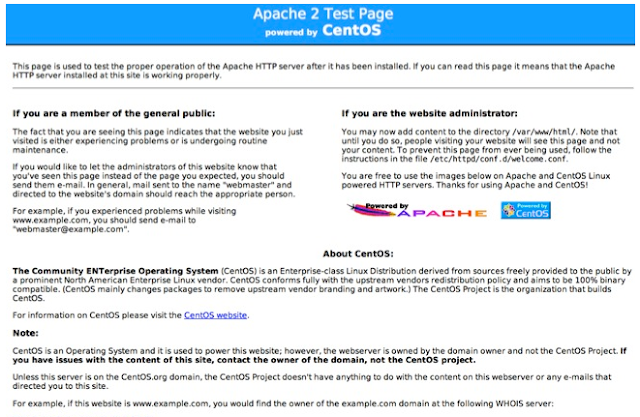 Question : how to configure http in Linux centos 6 , rhel 6
Question : how to configure http in Linux centos 6 , rhel 6Question : step by step http configuration in Linux cento6 , rhel6
Question : step by step http https configuration in Linux cento6 , rhel6
IP - 10.20.2.33
Hostname - khandwa.lokesh.com
OS - CentOS 6
PORT http - 80, https - 443
Apache is a freely available Web server that is distributed under an "open source" license. It s Supports all major distribution such as windows, Linux , Solaris and Mac operating system.
Some important directories are listed below
- " /etc/httpd -
Main Apache root configuration directory. - " /etc/httpd/conf.d -
Additional Apache configuration files provided by third party software - " /etc/httpd/conf/httpd.conf -
Main Configuration file. - " /var/lib/httpd/modules -
Configuration files for additional modules.( SymLink to /etc/httpd/modules) - " /etc/log/httpd -
Contains log files ( SymLink to /etc/httpd/logs) - " /var/www -
Main web document root directory.
Required Package Installaction by yum or rpm
# yum install http*
Restart service & on for every boot.
# service httpd restart
# checkconfig httpd on
Veryfiy service status
# service httpd status
Run several websites on the same server called a virtual hosting . Virtual hosts can be "IP-based", meaning that you have a different IP address for every web site, or "name-based", meaning that you have multiple names running on each IP address.
(*) you can set ip address of your server
NameVirtualHost *:80
Create a directory for contant of website , any name as you wish
# mkdir /var/www/html/lokesh.com
Create a index file under lokesh.com directory
# vi /var/www/html/lokesh.com/index.html
# vi /etc/httpd/conf.d/lokesh.conf
Go to insert mode & type following lines
<VirtualHost 10.20.2.33:80>
ServerAdmin lokesh@lokesh.com
DocumentRoot /var/www/html/lokesh.com
ServerName lokesh.com
ErrorLog logs/lokesh.com-error_log
CustomLog logs/lokesh.com-access_log common
</VirtualHost>
<VirtualHost 10.20.2.33:80>
ServerAdmin lokesh@lokesh.com
DocumentRoot /var/www/html/lokesh.com
ServerName lokesh.com
ErrorLog logs/lokesh.com-error_log
CustomLog logs/lokesh.com-access_log common
</VirtualHost>
Basic Configureation of HTTP is done now restart service , before restart service we Chack all configuration is ok or not ( check syntax error )
Check syntax error & Restart Service
# service httpd configtest
# service httpd restart
Part 2 ## HTTPs Configuration
Required Package & Installaction by yum or rpm command# yum install openssl
# yum install mod_ssl Or mod_nss ( only one of them)
Setting Up an SSL Server:
Secure Sockets Layer (SSL) is a cryptographic protocol that allows a server and a client to communicate securely. Along with its extended and improved version called Transport Layer Security (TLS), it ensures both privacy and data integrity. The Apache HTTP Server in combination with mod_ssl, a module that uses the OpenSSL toolkit to provide the SSL/TLS support, is commonly referred to as the SSL server. Red Hat Enterprise Linux also supports the use of Mozilla NSS as the TLS implementation. Support for Mozilla NSS is provided by the mod_nss module.
Enabling and Disabling SSL and TLS in " mod_ssl "
# vi /etc/httpd/conf.d/ssl.conf
Verify that all occurrences of the SSLProtocol directive have been changed as follows
#grep SSLProtocol /etc/httpd/conf.d/ssl.conf
# openssl s_client -connect localhost:443 -ssl3
Check Listen in : etc/httpd/conf.d/ssl.conf always enable with 443 port
Listen: 443
Generating a New Key and Certificate
#yum install crypto-utils
To run the utility:
# genkey <hostname>
# genkey khandwa.lokesh.com
Next
encrypt the private key = check & hit enter
set private key passphrase = choose pass & next
Next & Finish
Second Method For Generateing a key -:
Generate a self-signed certificate
Generate private key
#openssl genrsa -out ca.key 2048
>here ca.key is a key name & 2048 is key size.
Generate CSR
#openssl req -new -key ca.key -out ca.csr
Generate Self Signed Key
#openssl x509 -req -days 365 -in ca.csr -signkey ca.key -out ca.crt
#cp ca.crt /etc/pki/tls/certs
#cp ca.key /etc/pki/tls/private/ca.key
#cp ca.csr /etc/pki/tls/private/ca.csr
Note - If you have moved the files and not copied them, you can use the following command to correct the SELinux contexts on those files, as the correct context definitions for /etc/pki/* come with the bundled SELinux policy.
# restorecon -RvF /etc/pki
Then we need to update the Apache SSL configuration file and add your certs file
# vi +/SSLCertificateFile /etc/httpd/conf.d/ssl.conf
Create Directory :
# mkdir /var/www/html/khandwa.lokesh.com
Create a index file under lokesh.com directory
# vi /var/www/html/khandwa.lokesh.com/index.html
Create new virtual host file under additional configuration.
# vi /etc/httpd/conf.d/khandwa.lokesh.conf
<VirtualHost *:443>
SSLEngine on
SSLCertificateFile /etc/pki/tls/certs/ca.crt
SSLCertificateKeyFile /etc/pki/tls/private/ca.key
<Directory /var/www/html>
AllowOverride All
< /Directory>
DocumentRoot /var/www/html
ServerName khandwa.lokesh.com
ServerAdmin lokesh@lokesh.com
ErrorLog logs/khandwa.lokesh.com-error_log
CustomLog logs/khandwa.lokesh.com-access_log common
</VirtualHost>
SSLEngine on
SSLCertificateFile /etc/pki/tls/certs/ca.crt
SSLCertificateKeyFile /etc/pki/tls/private/ca.key
<Directory /var/www/html>
AllowOverride All
< /Directory>
DocumentRoot /var/www/html
ServerName khandwa.lokesh.com
ServerAdmin lokesh@lokesh.com
ErrorLog logs/khandwa.lokesh.com-error_log
CustomLog logs/khandwa.lokesh.com-access_log common
</VirtualHost>
#Service httpd restart
#Chkconfig httpd on
Access secure web server on blow link
https://khandwa.lokesh.com
















